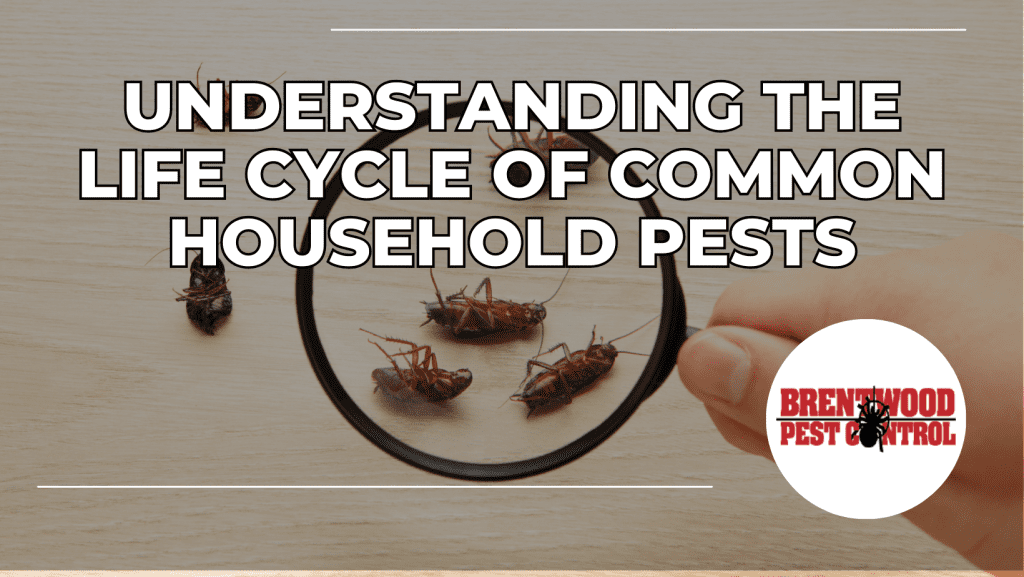
Pests are a nuisance to homeowners, causing significant damage to property and posing health risks to humans and pets. At Brentwood Pest Control, we believe that understanding the life cycle of common household pests is crucial for effective pest control. By comprehending how these pests develop and behave, you can better manage and prevent infestations. In this article, we will explore the life cycles of some common pests and how this knowledge can help in controlling them.
The Lifecycle of Pests
Most pests undergo four primary stages of development: egg, larva, pupa, and adult. The duration of each stage varies depending on the species of pest, environmental conditions such as temperature and humidity, and the availability of food and shelter. Let’s delve into these stages in detail.
Egg Stage
The egg stage is the initial phase in a pest’s life cycle. Female pests lay their eggs in suitable locations, such as on plants, in soil, or on food sources. The number of eggs laid varies widely among species.
– Flies: A common housefly can lay up to 500 eggs in its lifetime.
– Cockroaches: Some species can lay up to 50 eggs at a time and may produce several egg cases, resulting in hundreds of eggs.
– Mosquitoes: Female mosquitoes typically lay their eggs in clusters of 100-300 at a time and may lay multiple batches.
– Ants: Queen ants can lay thousands of eggs over their lifetime, with some species laying up to 1 million eggs annually.
Disrupting the reproductive cycle of pests is a crucial step in controlling their populations. For instance, insecticides can be used to target the egg stage, preventing pests from maturing and reproducing.
Larva Stage
After hatching, pests enter the larva stage, which is the feeding and growing phase of their life cycle. During this stage, larvae consume food to grow and develop, shedding their skin multiple times.
– Mosquitoes: Known as “wigglers” during the larva stage, mosquitoes pupate after feeding and then become adults.
– Ants: Ants undergo a larval stage that hatches from an egg, followed by a pupal stage before becoming adults.
– Beetles: Beetle larvae look significantly different from adults. For example, ladybug larvae resemble small alligators and are commonly known as “ladybug grubs.”
– Flies: Flies go through a maggot stage before pupating and emerging as adults.
Pupa Stage
The pupa stage is a non-feeding phase during which the larva transforms into an adult. Significant physical changes occur during this stage, making it a critical period in the pest’s lifecycle.
– Beetles, Flies, Ants, Bees, Wasps, Mosquitoes, Grasshoppers, Crickets, True Bugs, Lacewings, and Antlions: These insects all undergo a pupal stage where they transform from larvae to adults.
Understanding the vulnerability of pests during the pupa stage can help in timing pest control measures effectively. Targeting pests during this stage can prevent them from reaching adulthood and reproducing.
Adult Stage
The adult stage is the final phase of a pest’s lifecycle. Adults are capable of reproduction and can begin the cycle anew. The duration of the adult stage varies among species, ranging from a few days to several months.
How the Lifecycle of Pests Affects Pest Control
Understanding the lifecycle of pests is essential for developing effective pest control strategies. Targeting pests during their most vulnerable stages, often the larva or pupa stages, can enhance the effectiveness of pest control measures.
– Identification and Timing: Accurately identifying the pest and determining its lifecycle stage is crucial. For instance, if a pest is in the larva stage, a targeted insecticide may be more effective than a general pesticide. Timing treatments to coincide with vulnerable stages of the pest’s lifecycle can maximize their impact. Applying insecticides during the adult stage may be less effective if the pests have already reproduced.
– Comprehensive Control Plans: At Brentwood Pest Control, we design our pest control plans to target pests at all stages of their lifecycle. This holistic approach reduces the likelihood of reproduction and infestation, ensuring long-term pest management.
Understanding the lifecycle of pests is a fundamental aspect of effective pest control. By identifying pests and determining their lifecycle stages, pest control professionals can develop targeted strategies that effectively control pest populations. This knowledge helps prevent damage to property and allows homeowners to enjoy a pest-free environment.
At Brentwood Pest Control, we are committed to providing expert pest control solutions that address all stages of a pest’s lifecycle. For more information, visit our website or call us at (615) 417-1243 for further support. Let us help you create a safer, pest-free environment for your home or business.
